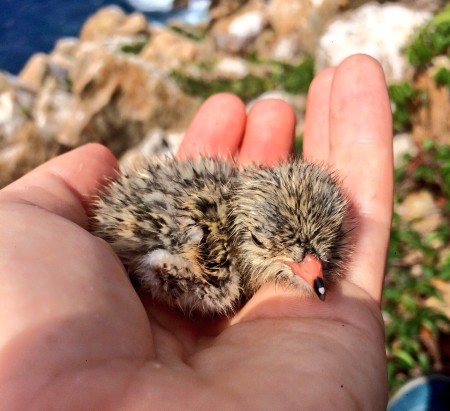
In the pursuit of wildlife research, I’ve climbed cliffs, dodged black bears, ridden in tiny planes through turbulent mountain air, jumped into surging ocean waters, and hiked alone through remote wilderness. None of these activities have scared me as much as handling my first Roseate Tern chick, a delicate ball of fluff just hours from the egg.
As I prepared to take a blood sample, hands shaking, I carefully stretched out the chick’s back leg, searching for the threadlike femoral vein. Anxious tern parents called and swooped above us in the early morning sky, and the chick peeped quietly in my hand. I angled the needle and, taking a deep breath, slid it gently in. My reward was a perfect bead of red blood. I transferred the blood into a vial of storage solution, handed Daniel the chick to return to the nest, and leaned back to savor the short moment of victory. One sample down, 29 to go.
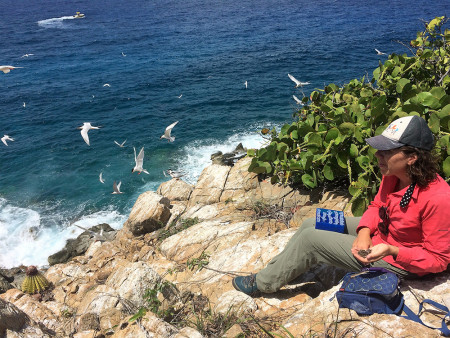
This spring I started my first full field season researching Caribbean Roseate Terns. These gorgeous Larids (bird family Laridae includes gulls, terns, and skimmers) are an especially challenging seabird to study, as anyone who’s tried will be quick to tell you. Like many seabirds, Roseate Terns nest on small islands, which offer a relatively predator-free habitat to raise chicks. Unlike many seabirds, they move colony sites almost yearly, for reasons we haven’t yet been able to determine.
In the Virgin Islands, which host ~50% of the Caribbean population, Roseate Terns have over 26 potential nesting cays that they choose from. That means that any research activities must first involve locating the birds, then figuring out a plan for that unique colony site. Caribbean Roseate Terns are also easily disturbed, and are prone to colony abandonment. Too much research activity in the colony could lower their reproductive success, which is the opposite goal of our efforts. For all these reasons, determining colony success through means such regular nest checks is not possible for this population, forcing us to get a little more creative.
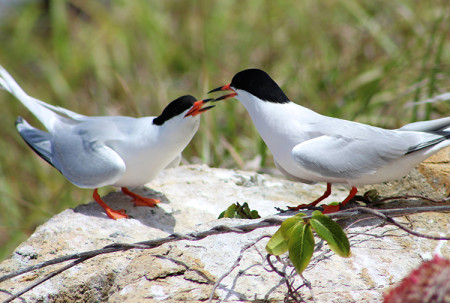
Because Roseate Terns have such a large range, and aren’t too interested in country boundaries, effective conservation planning for this species requires collaborating across borders. I’ve teamed up with researchers from several organizations in the Caribbean for this project, chief among them Susan Zaluski from the British Virgin Islands’ Jost Van Dyke Preservation Society and Daniel Nellis from the US Virgin Islands Division of Fisheries and Wildlife.
In addition to developing a standardized monitoring plan to use between the two territories, we are working to answer some of the basic questions regarding Roseate Tern ecology in the region. Because nesting cays are so difficult to regularly access, we’re using motion-activated game cameras installed at nests to be our eyes in the colonies. This year, we have cameras in six active colonies. We’re hoping that the images from these cameras will help us better understand the role of predation in colonies, as well as incubation behavior and hatching success.

Roseate Terns are declining across the Caribbean, and we don’t know why. Are population declines due to low nest success at colony sites, or to low adult survival on wintering grounds? The breeding season is only part of a Roseate Tern’s year, and come August they will leave the Virgin Islands. Band returns have indicated that the birds travel to wintering grounds in South America, but we know very little about their non-breeding movements.
Roseate Terns are smaller and lighter than other terns, and this has made following their movements using technology like satellite tags difficult. To answer some of the larger questions regarding population health and movement, we’re turning to another source: DNA. Caribbean Roseate Terns aren’t alone in North America—there is also a well-studied population in New England. These two populations are believed to share wintering grounds, but aren’t thought to interbreed. Such isolation is unusual for such far-flying seabirds, particularly as it’s thought that the migratory pathway of the Northeastern population takes them through the Caribbean.
We’re partnering with agencies in the US to determine relatedness between Caribbean and Northeastern Roseate Terns through genetic analysis. Genetic information will give us a better idea of the population health of Caribbean Roseate Terns, and will provide some intriguing clues on who they’re mixing with on their wintering grounds, which might better help us understand where they’re going.
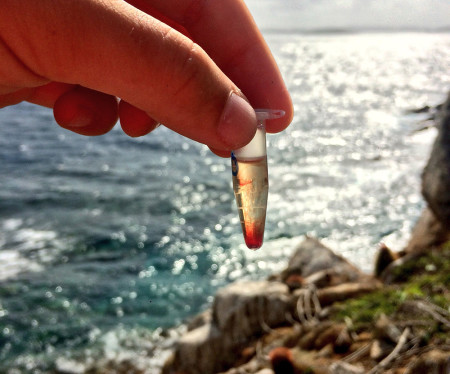
Which brings us back to that first morning of sampling. It’s best to get blood from chicks less than 3 days old. Younger chicks are easier to catch, and their skin is thinner and easier to pierce with a needle. They also seem to heal more quickly, with bleeding stopping within seconds—sometimes too quickly for me to get a full sample. All these sampling considerations make geneticist researchers like myself sound particularly, well, bloodthirsty, and have led to us being characterized as “vampires.” It’s a nickname I’ll proudly answer to, knowing as I do all the amazing secrets hidden in that remarkable substance.
Unlike mammal blood, avian blood is nucleated, meaning that every blood cell contains copies of DNA. That DNA can tell us the history of an entire species and beyond, if only we can find exactly the right questions to ask and the right tools for answering them.
Figuring out the best timing for our DNA sampling required four separate boat excursions to locate the most accessible tern colony and estimate when the majority of eggs would hatch. After deciding that LeDuck island would be the best candidate for sampling, we returned early one morning to swim our gear onto the islands in waterproof coolers, then hiked through waist-length thorny brush to reach the terns. I set up my sampling station on a flat boulder, and Daniel and my visiting husband worked the colony, locating the tiny chicks and bringing them to me bundled up in hats, hands, pockets, and bandanas. We moved between colony sections to allow anxious tern parents to return to their nests, working as quickly as possible to minimize stress to the colony.
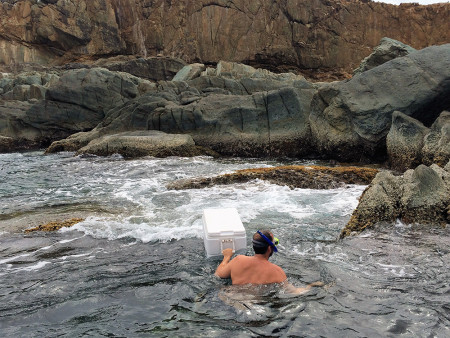
In all the haste, I still made sure to take a moment to breathe, look around, and enjoy the view. All that research planning, all those questions, came down to two short hours in the field and those 30 precious vials of blood. A year of collaborative effort went into my sitting on that boulder, first chick in hand, and I wanted to make sure that I took the time to appreciate it.
After the Birds Caribbean conference in Cuba (hope to see you there!) I’ll be heading back to Louisiana to lock myself in the lab and get started on analyzing all this data. I’m so excited to see where these results take us, and look forward to sharing my findings with you all in the future!
Paige Byerly is a PhD student at the University of Louisiana at Lafayette. Her research investigating genetic diversity among Roseate Terns in the Virgin Islands is supported by a grant from the BirdsCaribbean David S. Lee Fund and a research fellowship from the National Science Foundation. The Caribbean Roseate Tern, is a threatened metapopulation of Sterna dougallii dougallii, and thought to be declining across its range. Her research will help conservationists better understand the migratory ecology and population vulnerability of Roseate Terns.

So impressive Paige, that you can write such an informative but personal piece about something so important.
Thanks, Afford, for this really nice feedback. Paige is doing impressive work, we look forward to following her progress!